ISSN ONLINE(2319-8753)PRINT(2347-6710)
ISSN ONLINE(2319-8753)PRINT(2347-6710)
Mahesh M.Patil 1, Dr.R.R.Arakerimath2
|
| Related article at Pubmed, Scholar Google |
Visit for more related articles at International Journal of Innovative Research in Science, Engineering and Technology
The aim of present study is to analyze the performance, emission, and combustion characteristics of variable compression ratio (VCR), compression ignition (CI) engine using a suitable biodiesel as a fuel. The biodiesel is selected to conduct this experimental investigation is Compressed Natural Gas and Palm oil as a biodiesel in diesel dual fuel operation is regarded as one of the best ways to control emissions from diesel engines and simultaneously saving petroleum based diesel fuel. In the present work an experimental research was carried out on a laboratory single cylinder, four-stroke variable compression ratio, direct injection diesel engine converted to CNG-Diesel dual fuel mode and then blended with palm oil to analyze the performance and emission characteristics of pure diesel, CNG substitution rates and blended. The results reveal that brake thermal efficiency, brake specific fuel consumption, of dual fuel engine is in the range of 20%-60% at the rated load of 2,4 and 6kg which is Brake thermal efficiency is higher than pure diesel engine for 20% ,40% and 60% CNG substitution rates and slightly less in B20,B40,and B60. Brake specific fuel consumption of dual fuel engine is found better than pure diesel engine at all engine loads and for both CNG substitution rates but by applying biodiesel slightly grater than pure diesel due to its lower calorific value . It is found that there is drastic reduction in CO, CO2,and HC, emissions in the exhaust of dual fuel engine at all loads.
Keywords |
| Compressed Natural Gas; Palm oil; Dual Fuel Engine; Emission Analysis; Variable Compression Ratio Engine; Brake Thermal Efficiency; Brake Specific Fuel Consumption. |
INTRODUCTION |
| Currently, alternative fuels are being investigated in detail for application in compression ignition (CI) engines resulting in exciting potential opportunities to increase energy security and reduce gas emissions. Biodiesel is one of the alternative fuels which is renewable and environmentally friendly and can be used in diesel engines with little or no modifications. The objective of this study is to investigate the effects of biodiesel types and biodiesel fraction on the emission characteristics and performance characteristics of a CI engine. |
| Currently, alternative fuels are being investigated in detail for application in compression ignition (CI) engines resulting in exciting potential opportunities to increase energy security and reduce gas emissions. Biodiesel is one of the alternative fuels which is renewable and environmentally friendly and can be used in diesel engines with little or no modifications. The objective of this study is to investigate the effects of biodiesel types and biodiesel fraction on the emission characteristics and performance characteristics of a CI engine. engines is able to work fueled without any modification with blends from pure diesel up to B20 (Pahl G., McKibben B., 2008). |
II. MATERIAL AND METHODS |
| A. CNG and Palm oil as an alternate fuel for internal combustion engines: - Diesel engines can also be converted to run on CNG by installing a dual fuel conversion kit or converting the existing diesel engine into SI engine. In diesel engines CNG as a fuel can be used in dual fuel mode and offers the advantage of reduced emissions CO, HC, CO2, NOX etc. The higher Research Octane Number (130) for CNG as compared to that of petrol (87) allows a higher compression ratio (15.6:1) and consequently more efficient fuel consumption. Due to higher compression ratio Diesel engines can also use CNG as a fuel. But it cannot replace diesel completely like petrol due to poor cetane rating of CNG, [Singh R et al. (2012)]. Hence CNG seems a very attractive option for its use in diesel engines.Palm oil contains some triglyceride species, which are completely saturated. The iodine value of palm oil is lower (44-58) when compared to other vegetable oils because of high proportion of saturated fatty acids. Palm oil is solid at ambient temperature and fluid in tropical and subtropical climates with certain fractions held in crystalline form. It is used in manufacturing plastics, fibers and soaps. It is available in Asia, Africa, Indonesia, Nigeria and Malaysia. As a liquid fuel, biodiesel is simple to use and can be used in compression ignition (diesel) engines without modifications. |
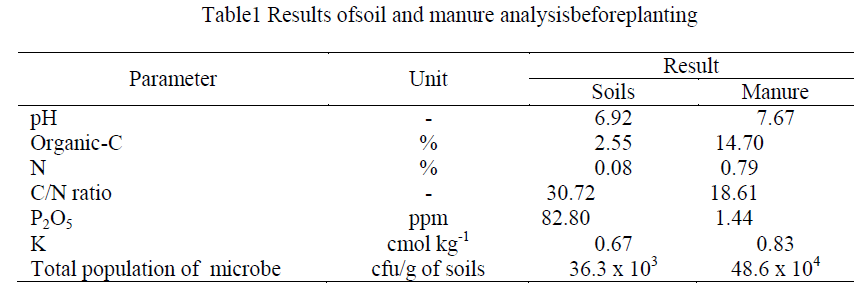 |
| B. Development of experimental test set up: - A single cylinder, 04 stroke, variable compression ratio, and water cooled diesel engine installed at laboratory. Internal combustion laboratory was converted to operate on dual fuel mode by carrying out minor modifications. The CNG fuel was mixed with intake air at a point in the intake manifold just outside the cylinder. For any set of operating conditions, the pilot fuel was kept constant while the amount of CNG fuel was gradually increased. The ignition delay period was established from records obtained using a water-cooled piezoelectric transducer. The injection timing was established using an electric inductance transducer. During the tests the injection timing was kept constant and the engine was operated at 1500 RPM, under naturally aspirated conditions. In the test set up a number of measuring and other ancillary instruments were used which included: test engine, CNG conversion kit, eddy current type dynamometer, air box with orifice meter and manometer, piezo-sensor range 5000PSI with low noise cable, crank angle sensor, data acquisition device, piezo-powering unit, digital milivoltmeter, temperature sensor, temperature transmitter, load indicator, load sensor, fuel flow transmitter, air flow transmitter, engine performance analysis software, rotameters, exhaust gas analyzer, etc. Fig.1 shows a schematic layout of engine test set up and Fig.2 shows actual image of CNG-Diesel dual fuel engine test set up. 2. Engine Specification shown in table no.2 the table gives all the technical specification of Single cylinder four stroke Diesel engine. The experimental study is to be conducted on a four stroke signal cylinder, variable compression ratio diesel engine using Palm oil with its blending with diesel (B20, B40, and B60). The thermal performance and emission characteristics are to be evaluated by running the engine at different preset compression ratios, and varying loads. All the testing result is obtained by “Engingsoft LV” software. It used to interface, record and analyze the data. |
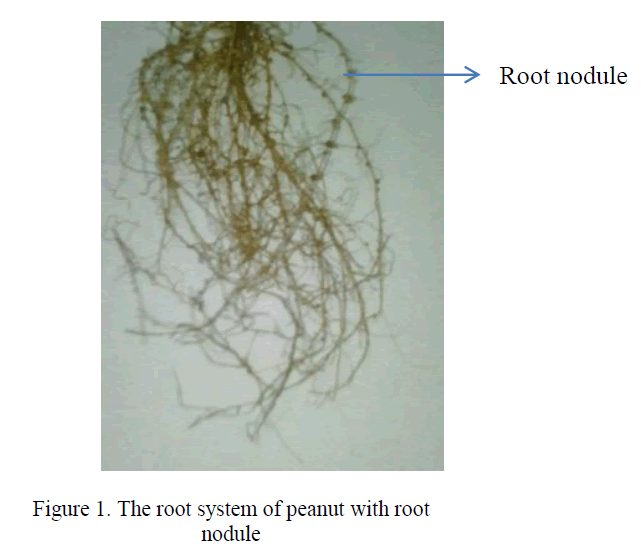 |
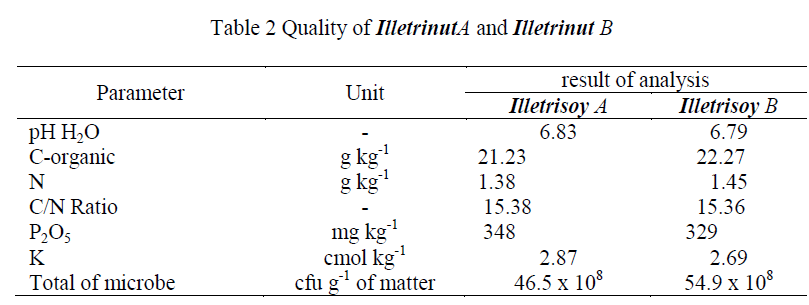 |
| C. Measurements and observations: - Start the engine and run under idling condition ( no load) for 10 minutes to ensure warm up and stedy operating condition take primary fuel as Diesel. Set the compression ratio at a selected value (say 15) using the tilting block arrangement for the engine. Record all the thermal performance parameters for no load condition through a data acquisition systems interfaced with the computer. A comericial software “Enginesoft LV” is used to interface, record and analyze the data. Then Adjust load for 2 kg using the loading unit dimmerstat and wait 3 minutes for engine to get stablized. Repete stpe procedure for 4kg and 6kg load to ensure correctness and reliablity/repetablity of the data recorded. The emissions were recorded by using Three Gas Analyzer (AVL Di Gas 444) and. Another set of reading was recorded for the operation of the engine in CNG-Diesel dual fuel mode. For this CNG conversion kit was switched ON and the flow of the CNG substitution rate was set at 20%. Similar set of readings were recorded for the compression ratio of 15 to 17. By changing it using the tilting head arrangement. Same set of readings were recorded for CNG substitution rate of 40%, and 60%. Same procedure repeated the B20, B40 and B60 by changing load and variable Compression the blending is already created on the basis of volume to volume Ratio. Performance parameters recorded were: engine load, brake thermal efficiency, brake specific fuel consumption etc. Exhaust gas emissions recorded were: CO in %, CO2 in%, unburned hydrocarbons (HC) in parts per million (PPM). |
III. RESULTS AND DISCUSSION |
| The results obtained by performing experiments by employing optimum operating conditions , under pure diesel mode and dual fuel mode of operation are compared and analyzed by representing them by graphically. |
| 1. Brake thermal efficiency analysis: - The variation of thermal performance parameters at different values of CRs at 15, 16 and 17 with a load of 2kg, 4kg, and 6kg and IP of 200 bar it represented in figure 3. |
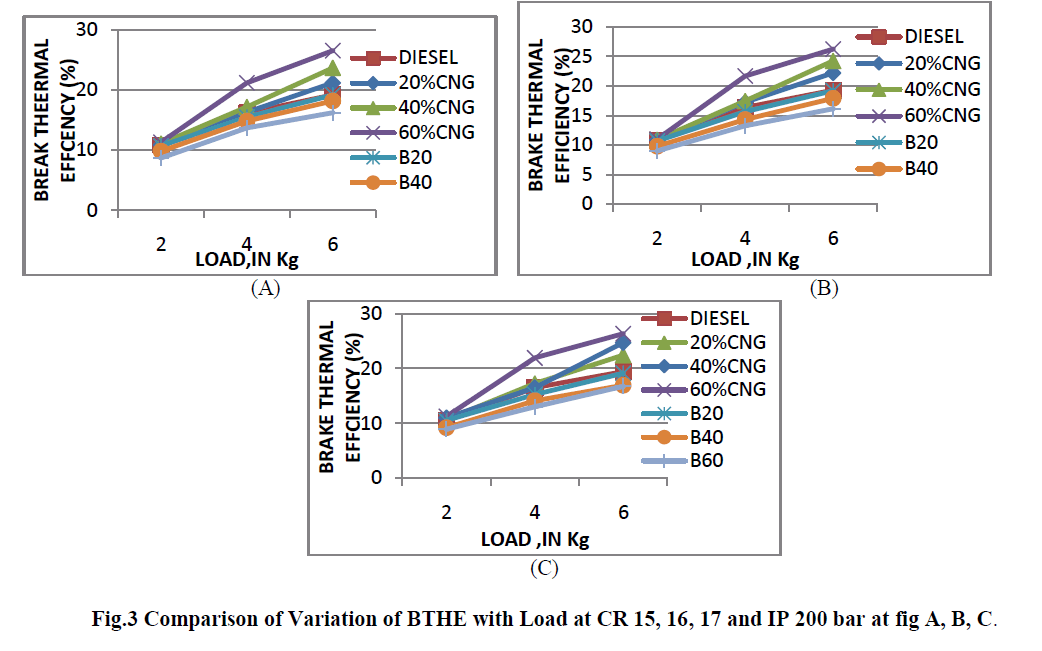 |
| It can be observed that BTHE increases continuously with increase in Load. The increasing trend is due to higher air temperature achieved at CNG substitution rate than biodiesel blends due to better combustion of fuel. It is also observed that BTHE is decreased with increase in biodiesel content in the blend at a CR 15 shown in figure A. The decreases may be due to higher viscosity of biodiesel which hinders the fuel evaporation due to poor atomization during combustion process. |
| From above three results clearly indicates at full load condition only Brake thermal efficiency increases continuously only CNG substitution rates as compare than pure Diesel and Palm biodiesel blends. The nearest result obtained at 20% CNG and B20 at same like as pure Diesel as shown in figures A, B and C. It depicts the variation of brake thermal efficiency with variation of engine load at CR of 17 for the CNG substitution rates of 40% and 60% and at both these substitution rates, B.TH.E. Of dual fuel engine is more than that of pure (0%CNG) diesel operation from no load to full load and this difference is maximum at full load and follow almost the same trend as at CR of 15 and 16 with slightly higher value at CR of 17. |
| 2. Brake specific fuel consumption analysis: - It can be observed that as the CR of the engine increases, then BSFC of decreases when load increases and result will obtained nearly 20% CNG is same BSFC as of pure Diesel but 40% CNG dual fuel mode is less than pure diesel mode it further decreases as the substitution rate of CNG is further increased to 60%. With CNG replacing diesel fuel, it contributes to extra heat energy on combustion resulting in better BSFC than diesel mode. This could also be due to higher calorific value of CNG, better mixing of air and CNG and improved combustion efficiency. And in palm biodiesel the BSFC is noticed to be decreases with increases in loads more biodiesel is consumed due to load demand and increasing with the increase in blend ratio shown by figure 4. |
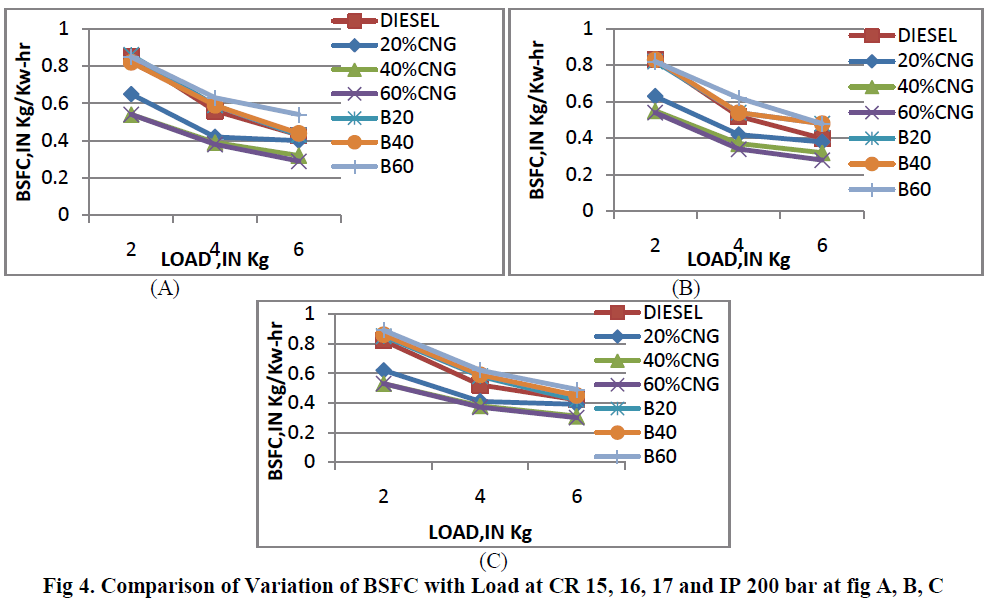 |
IV. EXHAUST GAS EMISSIONS ANALYSIS |
| 1. CO Emissions analysis:- It can be noticed that CO emissions increases as the load on the engine is increased for Diesel and duel fuel mode i.e. - CNG and Palm oil blends also it can be observed that CO emission decreases with increase in CR. There is more reduction in CO emissions at higher compression ratio of 17 than CR 15 and 16. The tested result at CR 15 and 6kg load are 0.02%, 0.02%, 0.015%, 0.015%, 0.018%, 0.012% and 0.011% in volume at 100% Diesel oil, 20%, 40%, 60%, B20, B40, and B60 respectively. And then CR 16 the tested results are 0.019%, 0.018%, 0.015%, 0.013%, 0.016%, 0.014% and 0.01% respectively and finaly at CR 17 the tested result are 0.017%, 0.017%, 0.015%, 0.013%, 0.014%,and 0.011% respectively. It will be clear that when higher CR then low CO emissions. Figure 5 shows the CO emission analysis. |
 |
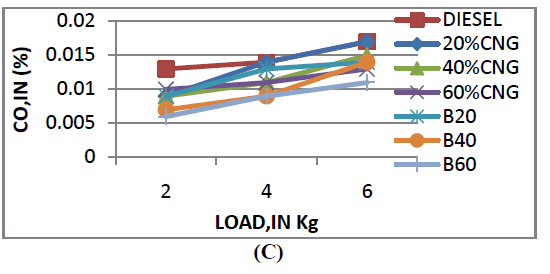 |
Fig 5. Comparison of Variation of CO with Load at CR 15, 16, 17 and IP 200 bar at fig. A, B,C |
| 2.CO2 Emission Analysis:- It can be observed that CO2 incraeses with increases in load for all fuels tested. The trends observed may be because of more fuel being burnt at higher loads due to which more carbon is available to form CO2. |
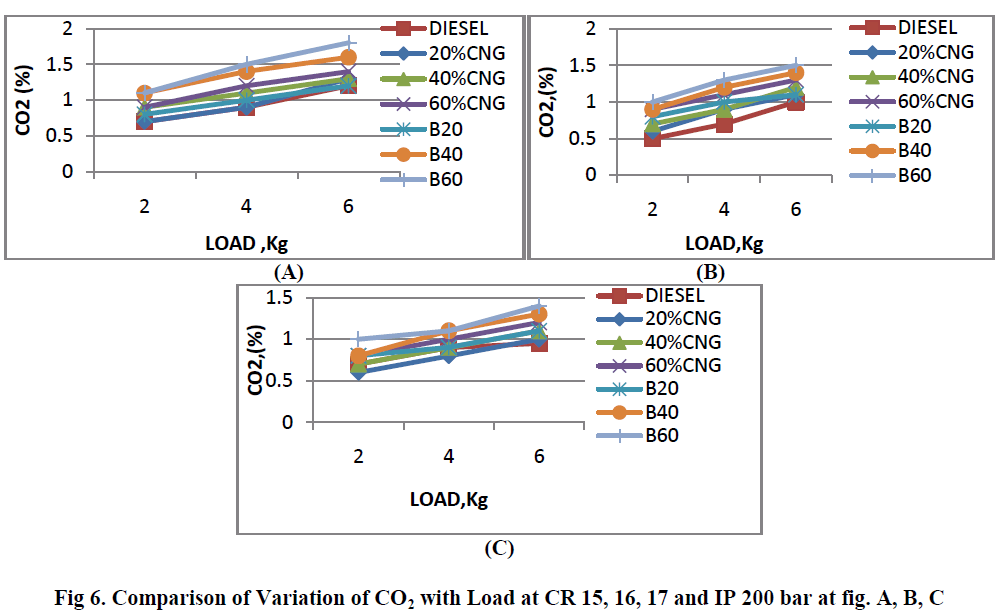 |
| The tested result obtained for CR 15 and at 6kg load is 1.2%, 1.3%, 1.3%, 1.4%, 1.2%, 1.6% and 1.8% at 100% diesel oil, 20%, 40%, 60%, B20, B40 and B60 respectively and at CR 16 tested result are 1%, 1.1%, 1.2%, 1.3%, 1.1%, 1.4% and 1.5% and finally at CR 17 the tested result are 0.95%, 1%, 1.1%, 1.2%, 1.1%, 1.3% and 1.4 % respectively. |
| 3.HC Emission Analysis:- The Percentage of HC is noticed to be increasing with increase of load and decrease with increase in percentage of blend of Palm biodiesel and CNG also. It can be observed that HC emissions decrease with increases in blend proportion at variable load. The trend can be attributed to the higher oxygen content in CNG than Palm as well as Diesel oil and hence complete combustion takes place inside the cylinder. HC emission increases by 20% to 50% for all blends when load is increases from 2 to 6kg. With the increases in blends ratio, up to 30% of reduction is observed in HC emissions for all the loads under consideration. The unburned HC emissions for Diesel oil vary between 4 to 6ppm and for 3 to 5ppm for CNG and for Palm oil biodiesel vary 2 to 3ppm. |
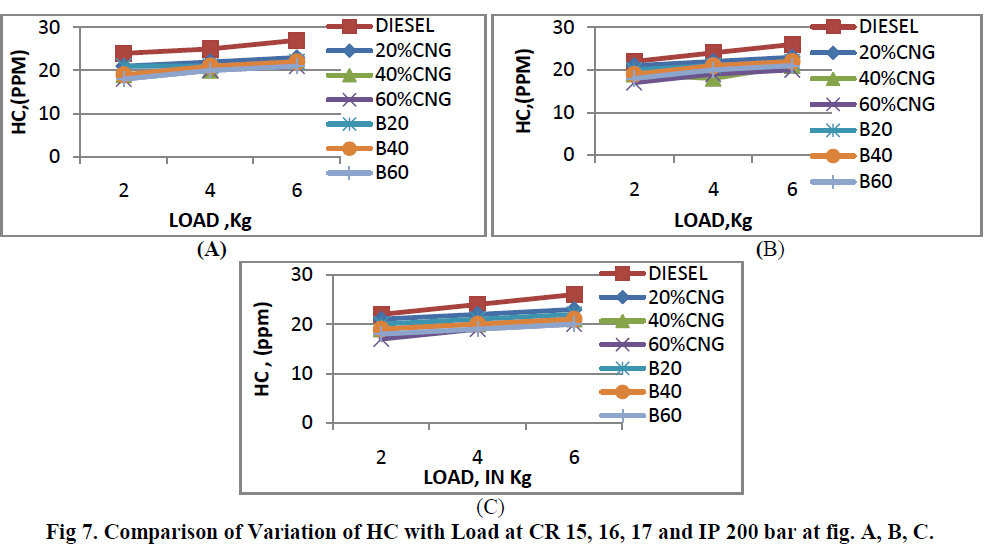 |
V.CONCLUSION |
| In the present experimental research on performance and emissions on use of CNG and Palm oil in a converted direct injection conventional diesel engine in dual fuel mode, thorough investigations on Three different compression ratios of 15, 16 and 17 for 20%,40% and 60%CNG substitution rates and B20,B40and B60. Biodiesels fueled dual fuel operation in both induction and injection modes resulted in poor performance compared to diesel operation. However, CNG injected dual fuel operation resulted in improved overall performance compared CNG inducted operation. It can be stated that port injection, as a methane supply method for dual fuel engines, is a very effective method to reduce unburned hydrocarbons. Shifting from homogeneous to port injection method, HC levels tend to decrease. From the injection method, it was observed that, BTE was increased by 0.5 % compared to induction method. The emission levels were obtained were smoke 7.69%, HC decreased by 13.33%, CO decreased. |
References |
|